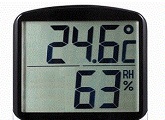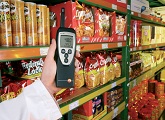January Newsletter - The sticky facts on humidity meters and using humidity meters in building maintenance
| January Newsletter - The sticky facts on humidity meters and using humidity meters in building
maintenance Happy New Year! 2012 is well and truly underway here at Instrument Choice. After a well earned break over the Christmas and New Year period we are back into the swing of things. To kick off the New Year we have welcomed a new member to the Instrument Choice Team, Daniel McGaffin. Daniel comes to us with a background in Environmental Management and a strong dedication to excellent customer service, which is a perfect fit here at Instrument Choice. Daniel will soon be able to help you with product advice, quotes, sales and calibration services once he has settled in, if you would like to ask Daniel a question or welcome him to the Instrument Choice Team his email is [email protected]. Here in Adelaide the weather has started to warm up, although we have still been experiencing a lot of rain (not that we are complaining), so we thought that it might be quite topical to talk about humidity meters this month. We will look generally at humidity, what it is , how its measured etc. and then we will take a closer look at how to monitor humidity levels in building maintenance. Remember; if you have any questions regarding tests you need to conduct or specific instrumentation please give us a call. Until next month... Tyson Grubb |
Whereas dew point is the temperature to which a given parcel of air must be cooled, at constant barometric pressure, for water vapor to condense into water. The condensed water is called dew. The dew point is a saturation point. When the dew point remains constant and temperature increases, relative humidity will decrease. Humidity meters can measure a number of different variables related to humidity depending on the type of meter. All humidity meters measure temperature; some more advanced meters also measure wet bulb temperature (an indication of evaporation rate) and dew point. We are pleased to be able to offer a wide range of humidity meters to suit many applications and price ranges. Types of Humidity Meters Ambient Humidity Meters - All of our humidity meters will measure the ambient humidity i.e. the humidity of the air surrounding the meter. Temperature and Humidity Meter with Probe - A digital humidity and temperature meter with a high accuracy and external humidity/temperature probe (generally made of plastic), these meters react quickly to humidity and temperature changes. Temperature, Humidity and Dew Point Meters - Temperature and humidity meters which also measure and display dew point. Digital Psychrometer – Is a specialist meter to measure wet bulb temperature, the meter also measures the humidity, dew point and air temperature. Dial Hygrometer – These are an alternative to digital hygrometers. With analogue meters there is an extra degree of error which occurs when having to manually read a dial; this makes them a less desirable option than a digital meter. Humidity Data Loggers – The range of data loggers will measure and record humidity and temperature in their internal memory for later download to the computer. You can then graph the results to easily see the changes over time. | |||
Humidity meters can be used to test instantaneous humidity levels in an area; you can move the meter to different locations and rooms and also use the meter to measure humidity in different parts of the room you are in. The popular models we provide are the C316, the HT-305 and the HD100S because they are good quality and accurate portable meters at an affordable price. A popular unit for monitoring humidity levels long term in different rooms is the IC7312 Jumbo display thermo-hygrometer. By using a humidity data logger you can easily get more information about the humidity in an area. Once setup a humidity logger can measure and record the humidity levels over time for later download. When finished you can download the information to your computer to view graphs and data showing exactly what has occurred. This allows you to get information of the changes in humidity levels (and temperature) throughout a day, week or year. Some of the most popular high quality data loggers used in building maintenance are the EL-USB-2+, the EL-USB-LCD+ and the HC1 Humidity Thermocrons, these are all easy to setup, download and are all trusted brands. Also, new to our range is the Microlite-PRO-RH which continues the tradition of the quality Microlite Plug and Record Mini Loggers. | |||


